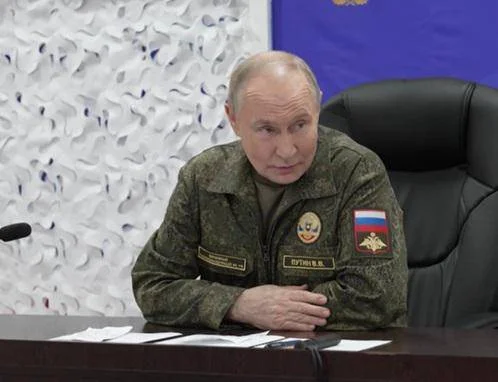Russia claims ‘liberation’ of Kupiansk. Ukraine is waiting to discuss a peace plan with Donald Trump. Vladimir Putin and Volodymyr Zelensky celebrated an important day, for different reasons, in the 4-year war. The Russian president, in one of his routine appearances in camouflage, visited one of the Western group’s command posts. Along with the army generals, the Kremlin leader gave his own summary: “The objectives of special military operations absolutely must be achieved”. Russia, he said, had taken control of Kupiansk, one of the centers of the conflict in recent months.
Moscow does not stop
“15 battalions of the Ukrainian Armed Forces are blocked in the Kupiansk region. The Ukrainian military must have the opportunity to lay down their arms and surrender”, Putin said, adding details about the new front of the war: “Fighting is already underway inside Konstantinovka”, in the Donbass.
Hence the accusation in Kiev: “Ukraine’s political leadership since March last year is nothing but a criminal group that has seized power. Representatives of the Kiev regime ‘sit on a golden toilet’ and do not think about the fate of Ukraine and its army,” he added, referring to the corruption scandal that befell the Ukrainian government. “The Kiev leadership maintains power for the sake of personal enrichment,” Putin commented.
General Valeri Gerasimov, Chief of the General Staff of the Russian Armed Forces, further elaborated on the picture. “The troops of the united group moved forward in all directionsthe city of Kupiansk was liberated. “More than 80% of the Volchansk region has been liberated,” he said, citing data and names.
Zelensky wants to talk to Trump
Russia will not take any quick steps, with the stated aim of consolidating its position regarding the real resumption of the negotiation process. Moscow aims to sit together in a position of strength to see their demands met. The basis of the negotiations must be a new US planprepared by Secretary of State Marco Rubio and Trump’s special envoy, Steve Witkoff,.
Kiev today announced that it had received a “draft plan” from the US and assured that it was ready to cooperate “constructively” with Washington on the issue. “The President of Ukraine has officially received a draft plan from the United States that, in the American assessment, could revitalize diplomacy,” the presidency announced via Telegram, adding that Zelensky intended to discuss it “in the coming days” with Trump.
“Peace is necessary and we appreciate the efforts of President Trump and his team to restore security in Europe. Ukraine defended life and freedom thanks to the courage of our people, our unity within the country, and the help of our partners,” Ukrainian President Zelensky said at X after his meeting with the US Army Secretary.
“In meetings with US Army Secretary Daniel Driscoll, we discussed options for achieving true peace, the order of our work and the format of dialogue, as well as a new impetus for diplomacy. Our teams – from Ukraine and the United States – will work on the terms of a plan to end the war. We are ready for constructive, honest and fast work.”
Trump’s 28-point plan
President Trump’s 28-point plan for peace in Ukraine requires Kiev, according to a draft cited by ‘Axios’, “to agree to include in its constitution that will not join NATO” and that “NATO agreed to include in its legislation a provision preventing Ukraine’s future entry” into the alliance.
But not only that. NATO, according to the plan, “agreed not to station troops in Ukraine.” Currently countries such as France and the UK are working on separate proposals that would involve sending small numbers of European troops to Ukrainian territory after the war. According to the US peace plan, “European fighters will be stationed in Poland”.
According to the plan “Ukraine’s sovereignty will be confirmed”; “a comprehensive non-aggression agreement will be agreed between Russia, Ukraine and Europe.” The plan also states “that Russia will not attack neighboring countries while NATO will not expand further.” It is planned that “a dialogue between Russia and NATO, mediated by the United States, will be held to resolve all security issues and create conditions for de-escalation in order to ensure global security and increase opportunities for future economic cooperation and development.”
Among the points of the US peace plan were that Ukraine agree “to become a non-nuclear state in accordance with the Treaty on the Non-Proliferation of Nuclear Weapons” and that the Zaporizhzhia nuclear power plant be placed under IAEA supervision, while “the resulting electricity will be distributed equally between Russia and Ukraine”. The two countries, claimed in the plan cited by ‘Axios’, “are committed to implementing educational programs in schools and society aimed at increasing understanding and tolerance of different cultures and eliminating racism and prejudice”. In particular, Moscow and Kiev “will agree to eliminate all discriminatory measures and guarantee Ukrainian and Russian media and educational rights.”
According to the plan, Russia “will not prevent Ukraine from using the Dnieper River for commercial activities, and an agreement will be reached on the free transportation of grain across the Black Sea.” Furthermore, “a humanitarian committee will be established to resolve outstanding issues: all remaining prisoners and bodies will be exchanged on an ‘all for all’ basis; all prisoners and civilian hostages will be returned, including children; family reunification programs will be implemented; steps will be taken to alleviate the suffering of the victims of the conflict.”
Finally, Ukraine must hold “elections within 100 days.” All parties involved in the conflict “will receive full amnesty for their actions during the war and agree not to make any claims or consider any claims in the future.” The agreement will be “legally binding” and its “implementation,” as envisioned in the Gaza peace agreement, “will be monitored and guaranteed by the Peace Council, chaired by President Donald J. Trump. Sanctions will be imposed for violations.” Once all parties accepted this memorandum, the plan concluded, “the ceasefire will take effect immediately upon the withdrawal of both parties at the agreed point to begin implementation of the agreement.”
Kiev would be forced to cede territory further east, limit the size of its armed forces and agree not to join NATO. In his plan, writes ‘Axios’, “Crimea, Luhansk and Donetsk will be de facto recognized as belonging to Russia, including by the United States. Kherson and Zaporizhzhia will be frozen along the line of contact, which means de facto recognition along the line of contact. Russia will cede any other agreed territories it controls outside the five regions.”
Ukrainian troops will withdraw from the part of Donetsk Oblast they currently control, and this territory, writes ‘Axios’, “will be considered a neutral and demilitarized buffer zone, internationally recognized as territory belonging to the Russian Federation. Russian troops will not enter this demilitarized zone”. The size of the Ukrainian Armed Forces, according to the plan, will be limited “to 600,000 people” while the Ukrainian army currently numbers about 800,000-850,000 people and, according to a Ukrainian official, had about 250,000 people before the war.
If Ukraine decides to invade Russia, “it will lose US guarantees”. According to the document, cited by ‘Axios’, furthermore, if Russia invades Ukraine again, “in addition to a coordinated and decisive military response, all global sanctions will be reimposed, recognition of new territories and all other benefits of this agreement will be revoked”. However, if Ukraine launches missiles at Moscow or St. Petersburg without reason, “security guarantees will be considered invalid.” According to the US plan, Ukraine “will be eligible for EU membership and will receive short-term preferential access to European markets”.
Regarding reconstruction, a “major comprehensive package of measures to rebuild Ukraine” is expected to come into force and will include “the creation of a Fund for Ukraine’s Development that will invest in fast-growing sectors, including technology, data centers and artificial intelligence.” The United States, estimates the US plan cited by ‘Axios’, “will collaborate with Ukraine to reconstruct, develop, modernize and jointly manage Ukraine’s gas infrastructure, including pipelines and storage facilities; joint efforts to rehabilitate war-affected areas for the restoration, reconstruction and modernization of cities and residential areas; infrastructure development; extraction of minerals and natural resources; the World Bank will develop a special financing package to accelerate these efforts”.
Russia, according to the US plan cited by ‘Axios’, “will be reintegrated into the global economy”. The lifting of sanctions “will be discussed and agreed on in stages and on a case-by-case basis”. The United States, it further underlined, “will enter into long-term economic cooperation agreements for joint development in the areas of energy, natural resources, infrastructure, artificial intelligence, data centers, rare earth mining projects in the Arctic and other mutually beneficial business opportunities.” Furthermore, according to the US plan, Russia “will be invited to rejoin the G8”. However, the frozen funds “will be used as follows: $100 billion of frozen Russian assets will be invested in US-led reconstruction and investment efforts in Ukraine; Furthermore, “a joint American-Russian working group on security issues will be established to promote and ensure compliance with all provisions of this agreement.”



